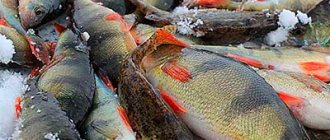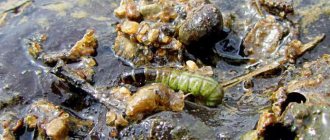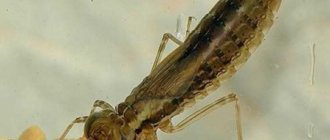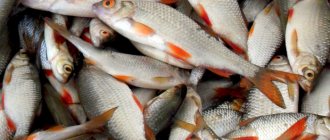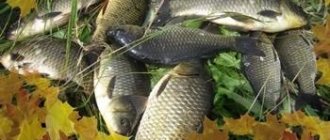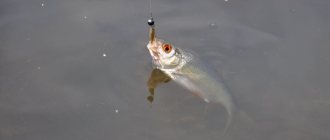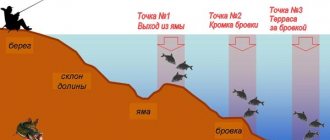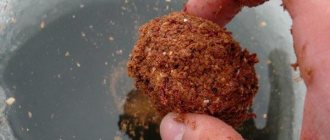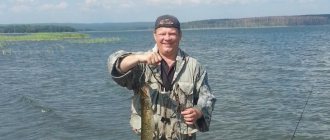general information
Lamprey larva
Depending on the area, the lamprey larva is called sand minnow, minnow, eel, spindle and even loach. This is not a fish, it is a larva that develops in rivers and streams with clean water. It has no scales, no bones, is only a few centimeters long, and has no gills.
In the Central Black Earth regions of Russia, the lamprey larva lives in almost all clean flowing water bodies. In most reservoirs, larvae are found in very small quantities and fishermen simply have no idea about this creature.
The larva develops for several years and lives in sandy-silty soil, in river backwaters, and in thickets of vegetation growing on sandy soil. Large larvae stick to riffles.
Lamprey habits and habitats
Lamprey is a nocturnal bottom fish. She does not like light and very often sticks to stones or snags located at the bottom, and, if possible, also buries herself in the silt. The lamprey spawns only once in its life, after which it dies. The egg hatches not into a fry, but into a larva called a sandworm. Most of all it resembles a worm and least of all an adult lamprey. In this state, the fish spends most of its life, about five years, and grows up to twenty centimeters.
Lampreys are found all over the globe, but not many species are edible. In Russia, river and brook lampreys are found in the Northwestern region and the Volga basin. Regardless of habitat, it spawns exclusively in fresh water. The length of an adult lamprey rarely exceeds forty-five centimeters, and its weight is one hundred and fifty grams. Fish live no more than seven years. Sandworms feed on microorganisms and detritus. An adult lamprey either does not feed at all or is a parasite on other fish.
Read! Fishing in the summer heat
Finding and catching larvae
This is a fairly simple method; for this you will need an ordinary iron bucket, a shovel or a wide metal ladle. Next, use a bucket or other object to scoop up a certain amount of muddy soil. Pour it onto a flat surface of the bank and level it out. Soon the larvae will reveal themselves with their quick, characteristic movements. And here you can no longer hesitate, the larva can instantly slip out of your hands and very quickly burrow right into the shore.
You can catch larvae using another method. To do this, you need 2 pieces of turf of approximately the same size, and attach them with the earthen part to each other. Then you need to make holes in these pieces of turf with a thin stick or wire. This lamprey larval trap should then be placed on some kind of mesh frame and immersed in water in the lamprey larval habitat. After 2-3 days, you can check the trap; larvae will probably be living in it. Other organisms, dragonfly larvae, leeches, and water worms can also live there. All of them, like larvae, can serve as excellent bait.
Methods for catching lamprey
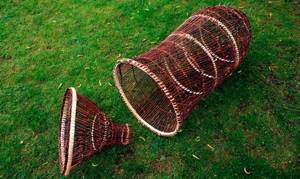
It is caught all year round, but is best from August to February. The structural and nutritional features of the lamprey require specific fishing methods. Most often they use various devices such as a hedge trimmer, a snout or a lichen, less often - a net and very rarely - their own hands. Sometimes they use the so-called light corridor - a trap at the end of a dark corridor between two streams of light. The lamprey cannot stand light and rushes along it in panic, avoiding illuminated places, and falls straight into a trap. The devices have one principle: the fish crawls into them, but cannot get back out.
Traps vary in shape and size:
- The smallest is the minnow, a type of snout. It looks like truncated cones inserted into each other. The length is 75 centimeters, the larger base is 30 centimeters in diameter, the smaller one is 15. A removable cone 30 centimeters long with an inlet diameter of 5 centimeters is inserted into the larger one, the smaller one is plugged with a stopper to facilitate fish removal. Material – veneer, rods, metal. Often made from five- or eight-liter bottles.
- The muzzle (beetroot) is a double scissor. Material – veneer or rods.
- The conch is essentially the same muzzle, only made in the shape of a barrel. A funnel up to half the length of the barrel is inserted into one side. Material – veneer.
Modern hems for lamprey come in different shapes and are made of knotless nylon.
An improved fishing spider top with 8 inputs will allow you to catch 3-4 times MORE FISH!
In winter, traps are placed under the ice or in gullies. At other times, they simply block the riverbed. Traps are placed along the shore or in shallow places with currents, immersed and firmly attached to the bottom. The entrance to them is directed against the movement of the fish.
Read! Fishing for carp in early spring
Fishing with lamprey larva
Small larvae can be used when fishing with a float rod, medium and large ones are suitable for bottom fishing.
When fishing, the sander must be kept near the bottom. The lamprey will not be able to burrow into the mud, since the hooks will interfere with it. Fish such as pike, pike perch, chub, asp, ide, and perch love to eat lamprey larvae. After the bite, there is no need to rush - you need to give the fish the opportunity to swallow the bait and then hook. It also happens that the fish is spotted on its own.
Lamprey larva on a hook
Medium and small larvae can be hooked onto a single hook through the mouth and brought out into the abdomen.
Large larvae are put on two hooks. One hook clings to the strong skin of the back, the second into the mouth and out through the front of the abdomen. To securely hold the lamprey wriggling on the hook, secure the removed hooks with a small piece of elastic.
Catching river lamprey with beetroot
River lamprey, on a more industrial scale, is caught using so-called beetroot or snouts. They are made from splinters or birch bark in a conical shape. The length of such gear is about an arshin. Next, a funnel is made in it, in its wide part, and the narrow part is plugged with a stopper. Quite a lot of beetroots are made and they are placed on one long rope with a distance between them of about an arshin. All this is installed at night on the river bottom so that the wide end is behind the current. You need to place it in places where fish move. It is better to do this on dark moonless nights. With the help of beetroot you can catch up to 50 lampreys per beetroot.
Description
Externally, lampreys look like eels or large worms, but they are not one or the other. They have no scales and their body is covered with mucus. Therefore, many people consider lampreys to be worms. However, they are primitive vertebrates, united by zoologists into a separate class of cyclostomes. The following factors indicate their relationship to vertebrates:
- There is a flexible elastic rod that replaces the spine.
- A chain of miniature paired cartilages that provide protection to the spinal cord.
- A skeleton composed of cartilage and connective tissue designed to protect the brain.
The mouth has a complex system of cartilage that provides support for the oral funnel and tongue. Representatives of this group do not have real jaws, and the mouth is rounded and looks like a suction funnel. On its surface and powerful tongue there are horny teeth.
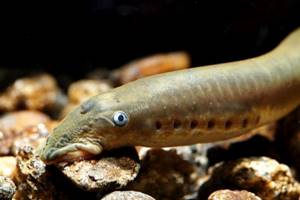
The photo shows that the head has three eyes (parietal and a pair of lateral ones) and seven gill slits on each side. Thanks to this feature, among the common people it received another name - seven-hole. There is one fin on the tail and another pair on the back. Lampreys are forced to spend most of their lives at the bottom of reservoirs, since they have neither a swim bladder nor paired fins. They are characterized by a nocturnal lifestyle. They prefer to swim alone, gathering in large groups during the spawning period.
Life expectancy is approximately 5-7 years.
Lamprey
Many people think that lamprey is an ordinary fish, but in fact it is not so. The appearance gives some indication that lampreys belong to the class of cyclostomes. These primitive creatures were the predecessors of fish in the process of evolution.
- Spawning
- Lamprey habitat
- sea lamprey
- Lamprey fishing
- Links
- Video
Most people make this big mistake, considering lampreys to be fish, due to the fact that this species lives in water bodies and behaves like a fish; lampreys have fins, although not in pairs. The body shape is something between fish and eels. Hagfishes also join the lamprey family.
These, in fact, were all the similarities between lampreys and fish. They have many more differences, let's talk about them.
- The spine of lampreys is replaced by a notochord, and they do not have a bony skeleton. The notochord is also called the dorsal chord; it consists of many cartilages.
- Lampreys have a huge number of glands that secrete a corresponding amount of mucus, so they do not need scales.
- This species does not have paired limbs.
- Most lampreys lack a jaw.
- The biggest difference is the respiratory system. In the picture you can see holes on the side of the lamprey - these are the so-called genres. The respiratory system is designed so that the gills are located inside in the form of bags. The holes that are visible in the picture connect the spherical internal bags with the external environment, other holes connect them with the pharynx. With the help of powerful muscles, water is sucked in and pushed out from the bags, so the lamprey can breathe even when it is eating. This is a vital function that is unique to the lamprey.
As you can see in the picture, the lamprey’s mouth is round in shape, equipped with a suction cup, inside which there are sharp teeth.
Under good living conditions and constant availability of food, lampreys reach three kilograms and grow up to 120 cm in length. Life expectancy is no more than 7 years.
Lampreys are divided into different subspecies. Among them there are inhabitants of the sea, fresh water and migratory ones. A special feature is that absolutely all lampreys can reproduce only in a freshwater environment. Lamprey larvae are yellow in color and resemble worms. They spend time in sand or silt.
Lampreys are considered a commercial fish; in many restaurants their meat is served as a delicacy; it costs quite a lot of money.
Several decades ago, the lamprey species found itself at risk of extinction. The construction of hydroelectric power stations and the release of chemicals into the water where lampreys spawn shorten the lives of their host fish.
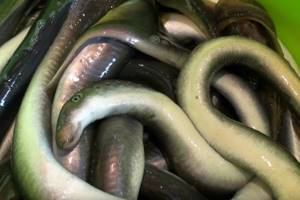
Spawning
Lampreys begin spawning in spring and until mid-summer. The duration of spawning depends on the region and temperature. They breed in deep sections of rivers, where the current is particularly fast and the bottom is pebbly. With the beginning of spawning, the fish gather in schools and begin nest construction. The lamprey nest is an oval depression, the construction of which is carried out by males. They cling to stones and, relying on their tail, move them to the sides of the nest. During construction, the female constantly circles above the male, thus supporting him. If other individuals appear around, the male attaches itself to the invader and drives him away from his habitat. After the nest is dug, the female makes it deeper and sweeps away excess sand. When the laying site is ready, the female clings to the stones, and the male to her. It wraps itself around it and both individuals spawn eggs and milk at the same time. After spawning, the exhausted fish goes to quiet places, hides in snags and stones, where it soon dies.
Lamprey habitat
This type of predatory fish is distributed throughout the world, depending on its habitat, there are three main types:
— stream or river (lives in freshwater bodies of water);
— sea (the name speaks for itself);
- checkpoint.
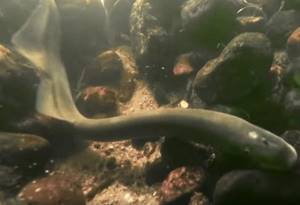
The freshwater species is distributed throughout Europe (North and Baltic Seas). In Russia, brook and river lamprey species are common, the first of which is smaller. Another difference between the two species is the dorsal fin. In the brook lamprey it becomes the tail lamprey, and in the river lamprey there is a gap between the fins. The Caspian lamprey differs from the river lamprey in the structure of its mouth. The river species can live not only in rivers, but also in lakes. For example, in Lakes Ladoga and Onega there is so much of this fish that fishermen catch it in buckets at once.
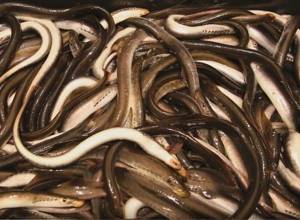
sea lamprey
The sea lamprey is the largest species of the entire order. Grows up to 2.3 kilograms and 120 centimeters. Like its brothers, the body is cylindrical and does not have paired fins. There are 7 holes on the front of the body through which the lamprey breathes. The dorsal fin has a gap. The oral funnel is distinguished by several circular rows of strong and sharp teeth. The anterior part of the tongue lacks a central groove. The color of individuals depends on age and habitat. Lampreys are often light gray and light green. A black marble pattern runs throughout the body. Lampreys that live in the seas spawn from June to July and die immediately after spawning. One female can lay up to 240 thousand eggs. The larvae live in rivers for the first 5-6 years, after which they go to the sea, where they live for about 2 more years. It should be noted that all lampreys go to rivers to spawn, even representatives of the marine species.
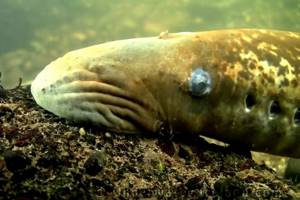
Lamprey fishing
In places where fishing is permitted, lampreys are caught with nets or traps. Feeding characteristics prevent the lamprey from being caught using standard baits. To catch lamprey, traps are placed very close to each other. The migration route is blocked by peculiar structures made of pegs, on which traps are hung. Lampreys' intolerance to bright light also allows lampreys to drive individuals into traps using special powerful spotlights that are lowered to the bottom of reservoirs. Lamprey larvae can be used as bait for bream, burbot, pike and other predators.
Links
Lamprey fishing in the Far East Spawning of lamprey - Spawning of lamprey. Channel 47 report Spawning of Ukrainian lamprey (Ukrainian brook lamprey) Spawning of sea lamprey (Ireland)
Video
+ Lamprey on a pike - video
Natural enemies and species status
Lamprey is a fairly large predator. However, she also has enemies. The seven-hole fish serves as a food source for larger species of fish and crustaceans. Of the numerous larvae, only a small part of them survive to adulthood, since they are often eaten by other inhabitants of the reservoir.
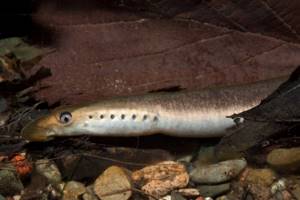
The fish that the lamprey feeds on can also be enemies. She can become food for the salmon she feasted on herself.
Lampreys do not have good relationships with all feathered representatives of the fauna. In shallow areas, herons and storks often retrieve seven-hole fish from under the silt. This happens in the daytime, when she buries herself in the silt, hiding from the sunlight that irritates her eyes. They can also be caught by diving birds such as cormorants.
Lampreys often become prey for burbots that live at the bottom of reservoirs. In sea waters during the winter season, belugas and other large fish pose a danger to it. Sometimes the semidyr becomes prey for Caspian seals and other mammals that live in water bodies.
Over the past decades, there has been a sharp decline in the lamprey population, caused by the construction of hydraulic structures and river pollution. In addition, the number of fish on which lampreys parasitize has decreased significantly.
